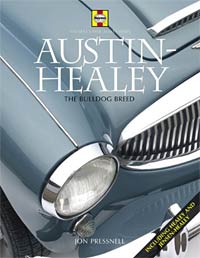|
Many British cars, even some of those that enjoyed success in their home market, didn't always find such levels of appreciation with buyers overseas. This cannot be said for the Austin-Healey though, in all its various guises, whether we're talking about the diminutive "Frogeye" Sprite, or the rally-conquering 3000s, as export orders for these cars flourished throughout the 1950s and 1960s. This book, by Jon Pressnell, guides the reader through the many different variations of Austin-Healey that appeared over the years, and also takes a close look at Donald Healey's cars from the years prior to his collaboration with the Austin Motor Company, and post-BMC with Jensen.
|
|
Chapter one describes the man himself, from his upbringing in Cornwall through to his time in the Royal Flying Corps. Following WW1 he established a garage in his home town, and began to take an interest in amateur speed events, initially in an ABC light car, followed by a string of other vehicles including Triumph Sevens, for which his garage held a franchise to sell new cars.
|
|
Following WW2, the Donald Healey Motor Company was formed. Chapter two describes the Riley-engined Healeys, illustrated with many period shots of the Elliott-, Abbott- and Westland-bodied cars, in addition to a variety of lesser-known, special-bodied, Healeys including those by Duncan Industries, Beutler, Peacock, and Dibbins, the latter producing a woodie estate-car on the Healey's chassis. In contrast, motorists looking for some high-speed action may well have been tempted by the Healey Silverstone, a two-seat sporting machine. Driving impressions, and tips on what to look for if planning to buy an early Healey, are also given.
|
|
There then follows description of the Nash-Healey, and the Alvis-Healey, before the main subject of this book is arrived at - the Austin-Healey, starting with the 100 of 1953 - 1956, designed with attacking the American market head-on, as a joint venture between Donald Healey and Leonard Lord, of BMC. The background design of each model is described in detail, aided by anecdotes from the people who were there at the time, working - often with limited resources - to get these cars into production and to the dealerships. If you want to know your BN1 from your BN2, this is a good place to start.
|
|
The 100-Six arrived on the scene thanks to BMC's decision to switch to the six-cylinder C-Series engine for their large saloons, resulting in Healey having to re-design the 100 to accommodate the larger, heavier unit. Again many period photographs of productions cars accompany the text, helping to explain the transition from model to model, as different variations of the Big Healey came on stream.
|
|
Proposals for a new Big Healey are discussed in chapter six, with various different options being considered and rejected, including appraisals of both the MGC and the Austin-Healey 4000, similar-looking to the 3000 but powered by Rolls-Royce's 4 litre engine, a unit that also found its way under the bonnet of the Vanden Plas 4 Litre R. These plans, as history and this book confirm, sadly came to nothing.
|
|
The 3000's understudy was of course the Austin-Healey Sprite, nicknamed the Frogeye or Bugeye in its original Mk1 guise. Powered by BMC's A-Series engine, it was designed as a fun, frugal little sportscar, a role it accomplished with honours, before evolving into the Mk2 Sprite, or "Spridget".
|
|
Austin-Healeys, either run by the factory, outside concerns or privateers, regularly featured in motorsport throughout the '50s and '60s, and coverage is given throughout the book to competition-prepared Sprites, and record breakers, although only two pages are given over to the rallying exploits of the Austin-Healey 3000 surprisingly.
|
|
Many readers will not have read about the Innocenti Spider and Coupe, based on the Sprite's running gear but enveloped in an attractive body designed by Ghia. Chapter 10 deals with these cars in detail.
|
|
For the 1970s a new collaboration was drawn up, the links with BMC having by this time withered on the vine. Jensen was to be Healey's new partner, leading to the creation of the Jensen-Healey, powered by the Lotus 907 four-cylinder unit. Reliability woes, issues with employee/manager relations, coupled to the looming oil crisis, all did their bit to ensure that the Jensen-Healey's gestation was not the smoothest. A beautiful car would have overcome many people's doubts about the new car, but feedback gained on the car's looks were lukewarm at best, handicapping the car from the beginning. Federal-spec bumpers on cars destined for the US did nothing for this Jensen's styling either (as with most cars of the time). By 1975 time was running out for the improving Jensen-Healey, the roadster by this time having been joined by a rakish estate car, reminiscent of Reliant's Scimitar SE5.
|
|
The remaining pages of this book take a look at attempts made in more recent times to resurrect the brand, the 3000 now fitted with modern running gear, and also design proposals for a brand new Healey. Only time will tell whether the Healey name will ever re-appear on a new-build sportscar for the future.
|
|
For anyone looking to gen up on Donald Healey the man, and the cars produced before and during his association with BMC, this book should prove to be a good source of information, although as mentioned, the Works rallying exploits with the Big Healeys don't receive a great deal of coverage here.
|
|
RJ
|
|
Back to top
|
|
Return to the Book Reviews main page
|





